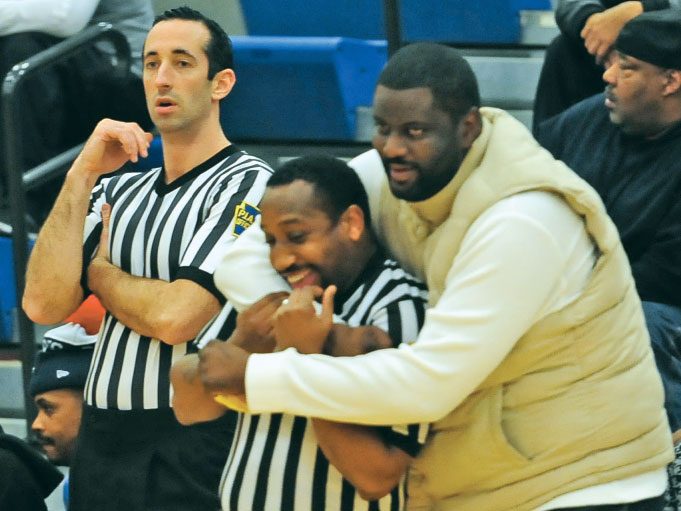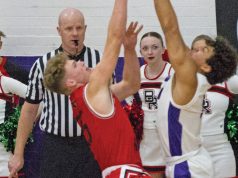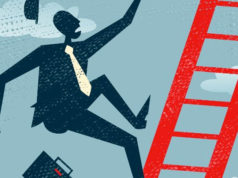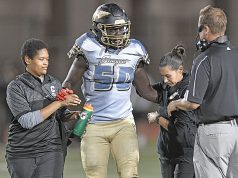According to the website deepenglish.com, the handshake dates back to knights in Medieval Europe. Mistrustful fellows, they would shake the hand of those they encountered in an attempt to shake loose any hidden weapons.
Over the years, the conventional handclasp has been temporarily supplanted by the waist-high, overhand double palms slap; the my-fists-bump-the-top-of-your-fists-and-you-respond-in-kind greeting; the so-called soul handshake, in which the greeter envelops the other person’s thumb with his hand; the high-five (double or single, depending on the level of emotion involved); and the frontal fist bump.
All of those gestures have been adopted by athletes at one time or another. But the modern competitor has supplanted or augmented simple mano a mano contact with bearhugging, lifting or tackling teammates in such a way that they find themselves at the bottom of a very large dogpile.
Rulemakers are constantly emphasizing the need to tone down physical contact between opponents during games. What about the officials? Certainly those of us in the enforcement division should never be roughed up or abused by players, coaches or fans. Is there any contact between officials and participants that’s OK?
No one objects to officials or umpires doing the old “shake and howdy” before the game, whether it’s in a formal setting such as the plate meeting before first pitch, in front of the bench ahead of the tip-off or somewhere on the field in advance of the opening kickoff. But make the shake firm, have it last only as long as necessary, and give both coaches an equal amount of “hand time.”
The longer you’re in this endeavor, the more familiar you’ll become with some coaches. In many cases, you’ll have earned their respect and their greeting will convey the confidence they feel knowing the game is in good hands. Don’t forget, however, the opposing coach may not know you as well and may look upon that congeniality as a bad sign for his team.
The NCAA issued a reminder to football officials that getting too chummy with participants is to be avoided. “Congratulating coaches or players is not appropriate,” the point of emphasis noted, “as it can lead to perceptions of bias.”
Officials touching players.
For those who officiate games involving minors, the subject of physical contact with players is especially sensitive. Even the most innocent-seeming gesture — a comforting hand on the back of an injured player, for instance — can easily be misconstrued.
Several years ago, an umpire working girls’ softball was accused of taking advantage of his position behind catchers to touch them inappropriately. He pleaded guilty to three counts of misdemeanor sexual battery and was sentenced to 204 days in jail.
It’s a bit different when working with adults, and far different in the pro ranks. World Cup final referee Pierluigi Collina and six-time MLS Referee of the Year Paul Tamberino would sometimes put an arm across a shoulder or hook an arm as they walked parallel paths with players. They did it to show empathy or make a point.
There is a debate regarding how physical officials should get if they are trying to prevent or intervene in a fight. It’s best if you can interpose your body between opposing players before it comes to blows, shield them away from each other, but don’t take any “offensive” action such as pushing or shoving.
Helping players off the ground isn’t a great idea, either. For one, it doesn’t look good if you do it for one player but not for one on the opposing team. Secondly, the player may be injured and shouldn’t be getting up.
Add it all up and the classic advice — don’t touch players or coaches — is the way to go.
Coaches touching officials.
Coaches and managers in baseball and softball are allowed onto the field to argue. That’s a tradition as old as the games themselves. The caveat is the discussion must stay within certain parameters.
Bumping an umpire or “billing” (using the peak of the cap to poke the umpire in the face), however, are grounds for immediate ejection.
UCLA assistant softball coach Lisa Fernandez got the gate last June for bumping umpire Erin Peterson in a discussion over an interference no-call. If you see an umpire pat his or her chest protector during a rhubarb, that’s an indication a bump has occurred and will be reported to the proper authority.
Occasionally a coach will use the official as a model to try to replicate an illegal act. In 1992, Notre Dame football coach Lou Holtz caused a national stir when he seemingly put referee Tom Thamert in a headlock to demonstrate how his players were being held. The officiating world was aghast that Holtz wasn’t penalized. Thamert insisted it was no big deal. How you react in those situations is up to you. If the coach is clearly trying to show you up or is overly enthusiastic in his or her demonstration, whatever sanction your sport allows is justified.
What about the coach who tries the buddy-buddy approach? You’re walking back onto the field or court after halftime and the coach who berated you the entire first half walks alongside you, drapes an arm around your shoulder and flashes a smile worthy of a toothpaste commercial. “Hey, I’m really sorry about all the yelling,” the coach says soothingly. “I’ll behave in the second half.”
Your first move is to get the coach’s arm off of you (via a shoulder shrug, a stop and turn, etc.). Again, that collegial arm around you gives onlookers a bad impression. As for the apology, “OK, coach. I’m looking forward to a quieter second half.” Then go on your merry way.
Official to official. You may not think touching another official is a problem. It may simply be another official doesn’t like to be touched.
When you must huddle with your partner or crew to sort out a play, resist the temptation to put your arms or hands on each other. Doing so implies one official is trying to reassure an official who kicked a call or one official is trying to influence another.
Avoid postgame handshakes while in view of fans on the court or field. Weird as it seems, it gives the impression you’re savoring the outcome. Save it for the postgame discussion.
Jeffrey Stern is Referee’s senior editor. He officiates high school football and formerly officiated college football and high school baseball.
What's Your Call? Leave a Comment:
Note: This article is archival in nature. Rules, interpretations, mechanics, philosophies and other information may or may not be correct for the current year.
This article is the copyright of ©Referee Enterprises, Inc., and may not be republished in whole or in part online, in print or in any capacity without expressed written permission from Referee. The article is made available for educational use by individuals.

















